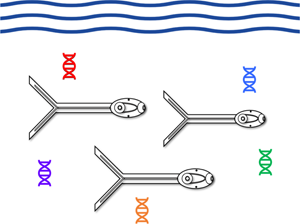Crossref Citations
This article has been cited by the following publications. This list is generated based on data provided by
Crossref.
Sures, Bernd
Nachev, Milen
Schwelm, Jessica
Grabner, Daniel
and
Selbach, Christian
2023.
Environmental parasitology: stressor effects on aquatic parasites.
Trends in Parasitology,
Vol. 39,
Issue. 6,
p.
461.
Truter, M.
Přikrylová, I.
Hadfield, K.A.
and
Smit, N.J.
2023.
Working towards a conservation plan for fish parasites: Cyprinid parasites from the south African cape fold freshwater ecoregion as a case study.
International Journal for Parasitology: Parasites and Wildlife,
Vol. 21,
Issue. ,
p.
277.
Sasser, Kristofer T.
and
Weber, Jesse N.
2023.
A call for more ecologically and evolutionarily relevant studies of immune costs.
Evolutionary Ecology,
Vol. 37,
Issue. 1,
p.
203.
Katz, Aron D.
Tetzlaff, Sasha J.
Johnson, Mark D.
Noble, John D.
Rood, Steven
Maki, Derek
and
Sperry, Jinelle H.
2023.
Molecular identification and environmental DNA detection of gill lice ectoparasites associated with Brook Trout declines.
Transactions of the American Fisheries Society,
Vol. 152,
Issue. 6,
p.
788.
Doherty, Jean‐François
Bhattarai, Upendra R.
Ferreira, Sara
Poulin, Robert
Gemmell, Neil J.
and
Dowle, Eddy J.
2023.
The proof is in the poo: Non‐invasive method to detect endoparasitic infection.
Molecular Ecology Resources,
Vol. 23,
Issue. 5,
p.
990.
Poyntz-Wright, Imogen P.
Harrison, Xavier A.
Pedersen, Siffreya
and
Tyler, Charles R.
2024.
Effectiveness of eDNA for monitoring riverine macroinvertebrates.
Science of The Total Environment,
Vol. 941,
Issue. ,
p.
173621.
Greben, O.
Kudlai, O.
Kuzmin, Yu.
Korol, E.
and
Syrota, Ya.
2024.
Helminth diversity in brine shrimps (Artemia) from Ukraine.
Journal of Helminthology,
Vol. 98,
Issue. ,
Douchet, Philippe
Haegeman, Bart
Allienne, Jean-François
Boissier, Jérôme
Senghor, Bruno
and
Rey, Olivier
2024.
The abundance of snail hosts mediates the effects of antagonist interactions between trematodes on the transmission of human schistosomes.
Infectious Diseases of Poverty,
Vol. 13,
Issue. 1,
Johnson, Mark
Tetzlaff, Sasha
Katz, Aron
and
Sperry, Jinelle
2024.
Comparison of qPCR and metabarcoding for environmental DNA surveillance of a freshwater parasite.
Ecology and Evolution,
Vol. 14,
Issue. 5,
Chew, Xian Zhe
Cobcroft, Jennifer
and
Hutson, Kate S.
2024.
Vol. 125,
Issue. ,
p.
105.
Okanishi, Masanori
Yoshigou, Hidenori
Tagawa, Kuni
and
Shibata, Naoki
2024.
An eDNA metabarcoding of brittle stars: Examples from the Seto Inland Sea, a semi-closed marine area.
Regional Studies in Marine Science,
Vol. 74,
Issue. ,
p.
103515.
Karaer, Mina Cansu
Karataş, Büşra
Madak, Elif
Sönmez, Hande İrem
Keskin, Emre
Sarımehmetoğlu, Hıfsı Oğuz
Kankılıç, Tolga
and
Tavşanoğlu, Çağatay
2025.
Characterizing the Helminth Community of the Mountain Gazelle (Gazella gazella Pallas, 1766) Through DNA Metabarcoding.
Acta Parasitologica,
Vol. 70,
Issue. 2,
Cook, Lauren S.J.
Briscoe, Andrew G.
Fonseca, Vera G.
Boenigk, Jens
Woodward, Guy
and
Bass, David
2025.
Microbial, holobiont, and Tree of Life eDNA/eRNA for enhanced ecological assessment.
Trends in Microbiology,
Vol. 33,
Issue. 1,
p.
48.
Thomas, Leighton J.
Zizka, Vera M. A.
Noll, Niklas W.
Scherges, Alice M.
Posanski, Michel
Bourlat, Sarah J.
Rulik, Björn
Mühlethaler, Roland
Lehmann, Gerlind U. C.
Koethe, Sebastian
Scherber, Christoph
and
Schäffler, Livia
2025.
Identifying conservation hotspots and assessing species commonness and rarity: Baseline arthropod diversity in German nature reserves via national Malaise trap monitoring.
Insect Conservation and Diversity,
de Buron, I.
Hill-Spanik, K.M.
Atkinson, S.D.
Vanhove, M.P.M.
Kmentová, N.
Georgieva, S.
Díaz-Morales, D.M.
Kendrick, M.R.
Roumillat, W.A.
and
Rothman, G.K.
2025.
ParasiteBlitz: Adaptation of the BioBlitz concept to parasitology.
Journal of Helminthology,
Vol. 99,
Issue. ,
Copedo, Joanna S.
Webb, Stephen C.
Delisle, Lizenn
Knight, Ben
Ragg, Norman L.C.
Laroche, Olivier
Venter, Leonie
and
Alfaro, Andrea C.
2025.
Elucidating divergent growth and climate vulnerability in abalone (Haliotis iris): A multi-year snapshot.
Marine Environmental Research,
Vol. 207,
Issue. ,
p.
107090.
